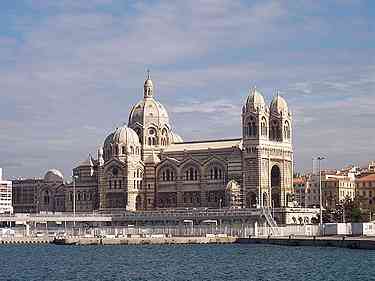Marseille Cathedral
| |
 มหาวิหารมาร์แซย์ | |
| สิ่งก่อสร้าง | |
|---|---|
| ฐานะ | อาสนวิหาร |
| นิกาย | โรมันคาทอลิก |
| ที่ตั้ง | มาร์แซย์ ในจังหวัดบุช-ดูว์-โรน |
| ประเทศ | |
| การก่อสร้าง | |
| แรกสุด | ค.ศ. 1852 – ค.ศ. 1896 |
| สร้างเสร็จ | |
| แบบสถาปัตยกรรม | ฟื้นฟูโรมาเนสก์ ฟื้นฟูไบแซนไทน์ |
| แบบผัง | กางเขน |
| ผู้ออกแบบ/ตกแต่ง | |
| ข้อมูลด้านการท่องเที่ยว | |
| พิกัด | 43°17′59″N 5°21′54″E / 43.29972°N 5.36500°E |
| เว็บไซต์ | มหาวิหารมาร์แซย์ |
| ประวัติศาสตร์
มหาวิหารมาร์แซย์ (อังกฤษ: Marseille Cathedral) หรือชื่อเต็มว่า อาสนวิหารนักบุญมารีย์องค์ใหญ่แห่งมาร์แซย์ (ฝรั่งเศส:Cathédrale Sainte-Marie-Majeure de Marseille กาเตดราลแซ็งต์-มารี-มาเฌอร์เดอมาร์แซย์) เป็นโบสถ์โรมันคาทอลิกที่มีฐานะเป็นอาสนวิหาร[1] ที่ตั้งอยู่ที่เมืองมาร์แซย์ในจังหวัดบุช-ดูว์-โรน แคว้นพรอว็องซาลป์โกตดาซูร์ ประเทศฝรั่งเศส มหาวิหารมาร์แซย์มีฐานะเป็นบาซิลิกาไมเนอร์มาตั้งแต่ปีค.ศ. 1896 และเป็นที่ตั้งอาสนะของอัครมุขมณฑลแห่งมาร์แซย์ (เลื่อนฐานะจากมุขมณฑลในปี ค.ศ. 1948)
มหาวิหารปัจจุบัน “Nouvelle Major” ที่สร้างอย่างใหญ่โตเป็นแบบไบแซนไทน์-โรมาเนสก์สร้างขึ้นระหว่างปี ค.ศ. 1852 ถึงปี ค.ศ. 1896 บนสถานที่ที่เคยเป็นมหาวิหารแห่งมาร์แซย์มาตั้งแต่คริสต์ศตวรรษที่ 5 โดยสถาปนิกเลอง โวดัวเย และอ็องรี-ฌัก แอ็สเปร็องดีเยอ (ค.ศ. 1829-ค.ศ. 1874) สิ่งก่อสร้างที่มีขนาดย่อมกว่าจากมหาวิหารเดิมที่ยังคงอยู่ “Vieille Major” ยังคงตั้งอยู่เคียงข้างมหาวิหารใหม่แต่ก็ถูกบดบังเพราะขนาดอันโอฬารของสิ่งก่อสร้างใหม่
มหาวิหารมาร์แซย์ได้รับการขึ้นทะเบียนเป็นอนุสรณ์สถานทางประวัติศาสตร์ เมื่อปี ค.ศ. 1906
| |
วันจันทร์ที่ 23 กุมภาพันธ์ พ.ศ. 2558
วันพฤหัสบดีที่ 19 กุมภาพันธ์ พ.ศ. 2558
ภาพทิวทัศน์ในยามค่ำคืน ซึ่งจะเห็นโบสถ์มัทธีอัส ปราสาทบรูดา สะพานแขวน Szechenyi และรัฐสภา
บูดาเปสต์
บูดาเปสต์ (อังกฤษ: Budapest; ฮังการี:Budapest [ˈbudɒpɛʃt] บูดอเปชต์) เป็นเมืองหลวงของประเทศฮังการี และเป็นศูนย์กลางการปกครอง อุตสาหกรรม พาณิชยกรรม และการคมนาคมขนส่งของประเทศ มีประชากรมากกว่า 1.7 ล้านคน มีจำนวนลดลงจากกลางทศวรรษ 1980 ซึ่งมีประชากรถึง 2.07 ล้านคน
บูดาเปสต์กลายเป็นเมืองเดี่ยวที่มีอาณาเขตครอบคลุมทั้ง 2 ฝั่งของแม่น้ำดานูบหลังจากการรวมกันในพ.ศ. 2416 (ค.ศ. 1873) ของเมืองทางฝั่งขวา ได้แก่ เมืองบูดอ (Buda) และโอบูดอ (Óbuda) เข้ากับเมืองเปชต์ (Pest) ทางฝั่งซ้าย (ฝั่งตะวันออก)
ปัจจุบันบูดาเปสต์เป็นเมืองที่ใหญ่ที่สุดเป็นอันดับที่ 6 ของสหภาพยุโรป
Budapest
right: Hungarian Parliament, Liberty Statue, National Theater, Matthias Church, St. Stephen's Basilica, Fisherman's Bastion, Heroes' Square, Chain Bridge and Buda Castle on the bank of Danube River and Panorama by night
Budapest /ˈbuːdəpɛst/ ( ; names in other languages) is the capital and the largest city of Hungary, and one of the largest cities in the European Union. It is the country's principal political, cultural,commercial, industrial, andtransportation centre,[] sometimes described as the primate city of Hungary. In 2011, according to the census, Budapest had 1.74 million inhabitants, down from its 1989 peak of 2.1 million due to suburbanisation.[] The Budapest Metropolitan Area is home to 3.3 million people. The city covers an area of 525 square kilometres (202.7 sq mi)[17]within the city limits. Budapest became a single city occupying both banks of the river Danube with its unification on 17 November 1873 of Buda and Óbuda, on the west bank, with Pest, on the east bank.
; names in other languages) is the capital and the largest city of Hungary, and one of the largest cities in the European Union. It is the country's principal political, cultural,commercial, industrial, andtransportation centre,[] sometimes described as the primate city of Hungary. In 2011, according to the census, Budapest had 1.74 million inhabitants, down from its 1989 peak of 2.1 million due to suburbanisation.[] The Budapest Metropolitan Area is home to 3.3 million people. The city covers an area of 525 square kilometres (202.7 sq mi)[17]within the city limits. Budapest became a single city occupying both banks of the river Danube with its unification on 17 November 1873 of Buda and Óbuda, on the west bank, with Pest, on the east bank.
The history of Budapest began withAquincum, originally a Celticsettlement that became theRoman capital of Pannonia Inferior. arrived in the territory in the 9th century. Their first settlement was pillaged by the Mongols in 1241–42. The re-established town became one of the centres of Renaissance humanist culture in the 15th century. Following the Battle of Mohács and nearly 150 years ofOttoman rule, the region entered a new age of prosperity in the 18th and 19th centuries, and Budapest became aglobal city after its unification in 1873. It also became the second capital of the Austro-Hungarian Empire, a great power that dissolved in 1918, following World War I. Budapest was the focal point of the Hungarian Revolution of 1848, the Hungarian Republic of Councils of 1919, Operation Panzerfaustin 1944, the Battle of Budapest in 1945, and the Revolution of 1956.
Cited as one of the most beautiful cities in Europe, Budapest's extensiveWorld Heritage Site includes the banks of the Danube, the Buda Castle Quarter,Andrássy Avenue, Heroes' Square and the Millennium Underground Railway, the second-oldest metro line in the world.[27][29] It has around 80 geothermal springs,[30] the world's largest thermal water cave system, largest synagogue, and third largest Parliament building. The city attracts about 4.3 million tourists a year, the 25th most popular city in the world, and the 6th in Europe, according to Euromonitor.
Considered a financial hub in Central Europe, the city ranked 3rd onMastercard's Emerging Markets Index,[34] and ranked as the most liveable Central or Eastern European city on EIU's quality of life index. It is also ranked as "the world's second best city" by Condé Nast Traveler,"Europe's 7th most idyllic place to live" by Forbes, an as the 9th most beautiful city in the world by UCityGuides. It is the highest ranked Central/Eastern European city on Innovation Cities' Top 100 index.
Budapest is home to the headquarters of the European Institute of Innovation and Technology (EIT), and the first foreign office of the China Investment Promotion Agency (CIPA). Eighteen universities are situated in Budapest, including the Central European University, Eötvös Loránd Universityand the Budapest University of Technology and Economics.
สมัครสมาชิก:
บทความ (Atom)
.jpg)
.jpg)
.jpg)
.jpg)
.jpg)
.jpg)
.jpg)
.jpg)
.jpg)

.jpg)

.jpg)
.jpg)
.jpg)







